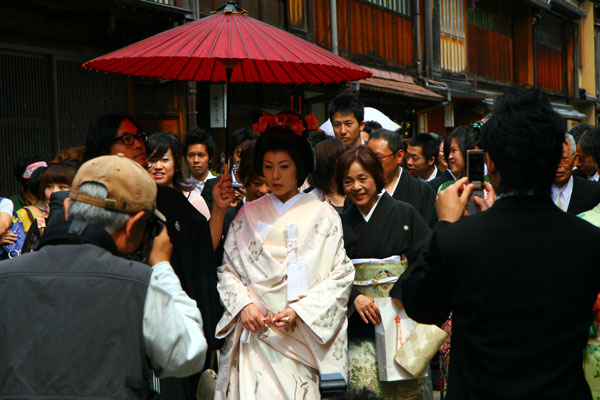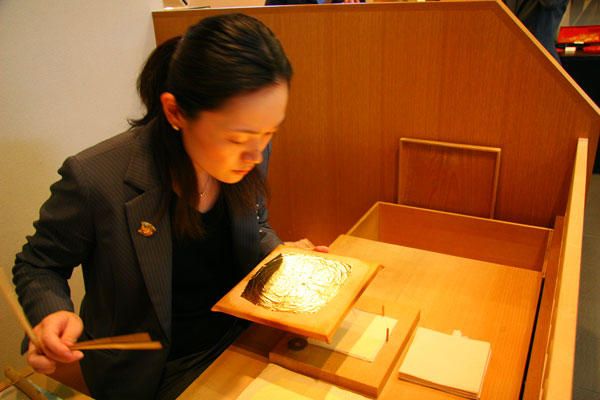
Most first-time tourists consider Tokyo and Kyoto as top destinations, at the expense of the unfairly underrated Central Japan. So this article will the first of a series on my favorite region in Japan, so beautiful and culturally interesting, yet sadly missed by most Western tourists. I'll start with one of the most overlooked destinations of this overlooked region -- with the old castle town of Kanazawa.
Kanazawa is an old provincial capital on the sparsely populated Sea of Japan coast, which faces the Korean Peninsula as opposed to facing the Pacific Ocean like Tokyo and Osaka. Its two-hour distance from the Shinkansen (bullet train) line keeps Kanazawa relatively unknown to most Westerners, but to the Japanese it is one of the top domestic destinations, famous for a wide variety of touristic appeals -- well-preserved Edo-period townscapes, one of the countries' most famous landscape gardens, traditional gold-leaf production, and my favorite of all, incredible seafood.

If you're wondering what was happening in the picture at the top, we visited Kanazawa's famous Geisha quarter of Higashi-Chayagai on a Sunday and came across one of the most picturesque weddings I've ever seen -- a lovely couple dressed in traditional gowns, being wedded in the most romantic of places. It was quite a spectacle even to the Japanese, and some of the excited female bystanders rushed to shake hands with the bride and to offer congratulatory greetings. The *entire* neighborhood came out to take pictures, much to the annoyance of the bride I think.

The word "Chaya" (teahouse) in Higashi-Chayagai was an euphemism for brothel back in the old days, so the selling point here was never about tea. Even today a few real Geisha houses remain along the banks of the Asano River, though the most famous, Ochaya Shima, has been declared a National Important Cultural Asset and turned into a little museum. Most of the other traditional houses now operate as upscale restaurants or flagship stores for Kanazawa's historical handicraft industries.
The neighborhood still retains much of the feudal atmosphere, with kimono-clad ladies walking alongside the traditional two-storey Machiya townhouses. Compared with the internationally famous Kyoto, domestic tourists make up most of the visitors here, and it will probably remain so until the planned Hokuriku Shinkansen Line provides direct bullet train connection between Tokyo and Kanazawa in 2014.

And if you want to enjoy this traditional beauty without any tourist crowds, there is another lesser known but equally charming "Chayagai" area just 5 minutes walk to the South, along the other bank of the Asano River. IMHO the Kazue-machi Chayagai preserves the authentic atmosphere even better than Higashi-Chayagai, with less commercial activity, a couple of Ryokans you can stay in, and most importantly an entire row of Sakura trees going into full bloom every spring.
On this day we spotted this Shamisen-playing lady coming out of one of the Machiya townhouses. An instructor to the Geishas? Or perhaps a former Geisha herself? Sadly we'll never know, but that's also part of the Geisha quarter's attractive mystique.

Surprises await at every street corner and back alley, so visually stunning that one may be forgiven for mistaking it for Kyoto. But in reality you can hardly take an unobstructed photo at Kyoto's tourist districts nowadays, so in some cases Kanazawa could be said to match the casual tourist's expectations better than Kyoto itself.

For any camera-toting tourist, it's simply impossible to come back without good pictures at a place like this. If you need more reasons to visit, yes this stunning but nameless shrine was also part of Kazue-machi Chayagai.
I should mention that there's a third Chayagai in Kanazawa, located southwest of the Korinbo commercial district, which we never visited. It was just a little too far from our planned route.

Visiting Kanazawa's famous Chayagai and Garden are fine for casual tourists, but if you want to delve a little deeper and do what the locals do, then you need to understand Kanazawa's importance as the capital of the traditional gold-leaf production industry. In fact Kanazawa is estimated to produce 98% of Japan's gold-leaves, including those used to cover Kyoto's Golden Pavilion. So any Japanese tourist visiting Kanazawa arrives with expectation from friends and coworkers that he will come home with some sort of gold-leaf handicraft items as Omiyage.
Gold-leaf covered souvenirs aren't as expensive as one may think, often starting from as low as 800 yen (CAD$8) or so for a little pendant. And even if you have no plan to shop, the gold-leaf factory and showroom is quite an interesting place to visit. If you're visiting Higashi-Chayagai anyway, the headquarters of gold-leaf production giant Hakuza (http://www.hakuza.co.jp/english) is only a few minute's walk to the North.

By far the most impressive sight at Hakuza is a modern reproduction of 16th Century Shogun Hideyoshi's "Golden Tea Ceremony Room". This picture doesn't do any justice to the excess grandiose of the small but incredibly lustrous room -- if 50 Cent is your definition of bling, you should really see this place.

Even though we dressed like the poor backpackers we were, it didn't stop the manager from putting on her best demonstration of gold-leaf production just for the two of us. First she took one incredibly thin sheet out of a stack of gold sheets using a bamboo tweezer.

Placing the gold sheet on a thin leather cushion, she then spread open the sheet with just a soft blow of her breath.

The gold sheet was then trimmed according to a standard-sized piece of pounding paper. The trimmed sheet was then stored inside a sheet stack, with each sheet individually separated by a piece of pounding paper.

What happens to the unwanted edges? Most goes back to the pounding room to be recycled into fresh sheets, but a few squares end up on the hands of inquisitive tourists like ourselves. We had no idea what to do with them, before the staff told to apply the gold to our faces as a facial treatment. Weird.

The service here was of course living up to the legendary Japanese quality one would expect, with complimentary tea and dessert covered with ... what else ... gold leaves and gold flakes. Being educated in the Western world I'm naturally skeptical of heavy metal ingestion, but here in Kanazawa they lavishly decorate any higher priced dishes with gold flakes, as you'll see in the food pictures in the next article.

There's no obligations to buy anything, but we did come away with this little gold leaf coated owl, at a reasonably price of 1050 yen (CAD$10). But the best bargain by far was two small bag of transparent, gold-leaf-infused hard candies for 578 yen (CAD$6) each, a unique and exotic present appearing several times its price and absolutely amazed my wife's coworkers.

But the ONE tourist attraction everyone comes to see is the 230-year-old Kenrokuen, one of the "Three Famous Gardens" of Japan and THE symbol of Kanazawa. This two-legged lantern is probably the most overused image featuring on every tourist brochure, followed by the snow-covered image of a conical array of ropes attached to the Karasaki pine tree for achieving even distribution of snow fall.

No intricate rope arrays could be found during our summer visit, but the famous pine tree still gracefully postured on the lakeside with the help of the supportive pillars. The garden also features Japan's first gravity-powered water fountain, a 200-plus-year-old tea pavilion, beautiful plum blossoms in springtime and autumn foliage. Personally I don't consider Kenrokuen to be Kanazawa's primary attraction the way it's often advertised, but with the wide array of quality attractions in the city, it doesn't need to be.

On the other side of the castle grounds lies the Nagamachi Samurai District with its centuries-old earthen walls and narrow lanes -- middle-class feudal architecture at its purest. A couple of the best-preserved Samurai houses have been converted into museums, and a few others into pottery and silk-dyeing workshops. It's really the most charming of places for a quiet romantic stroll.
There are so many places worth visiting in this little city that we didn't even have time for a few fairly famous attractions -- the Myoritsu-ji (more popularly known as the Ninja Temple), Nishi-Chayagai Geisha Quarters, and the grounds of the Kanazawa Castle Park would all make great outings, should we had stayed for a couple more days.
But even if we had to miss all of the above attractions, there's ONE THING we would never miss on any visit to Kanazawa ... the incredibly fresh seafood at the historical Omicho Market.

Many sushi connoiseurs hail Tokyo's Tsukiji Market as the Mecca of fresh sushi, and with good reasons (see our visit from 3 years ago). But where does the fish in Tsukiji come from? A good portion actually comes from the Sea of Japan fisheries off the coast of Kanazawa, so at least theoretically the seafood here should be as least as fresh as Tsukiji's. Being hopeless seafood lovers ourselves, we went to Kanazawa's 280-year-old Omicho Market to test out this theory.

Hokkaido has its famous sea urchins, Ise hails its lobsters, but in Kanazawa, the Zuwaigani (snow crabs) rules as the undisputed King of Seafood, shown here priced from 3500 to 6000 yen (CAD$35-$60) each. If you think $60 is a steep price for one crab, it would have been twice that price had we arrived during the winter crab season. But mid May wasn't a bad time for a visit since it was the best season for other delicacies...

...such as the egg-carrying Hotaru Ika (fluorescent squid), which has become my wife's favorite seasonal seafood on this trip. But in addition to being delicately steamed and served fresh in restaurants, here in Kanazawa they're also sun-dried, sold as street snacks, and eaten in an authentically local and strange manner -- the vendor lady taught us to use a cigarette lighter, quickly char the skin of the squid, then pop it whole in one bite -- tentacles, roes and all.
Fascinating place isn't it? That's why we had all our breakfast, lunch and dinner inside the Omicho Market during our stay in Kanazawa. If you're seafood lovers like us, there's no better place. In fact we have so many food pics from Kanazawa that I'm going to move them to the next article ... sorry, I'll post them next week.
Không có nhận xét nào:
Đăng nhận xét